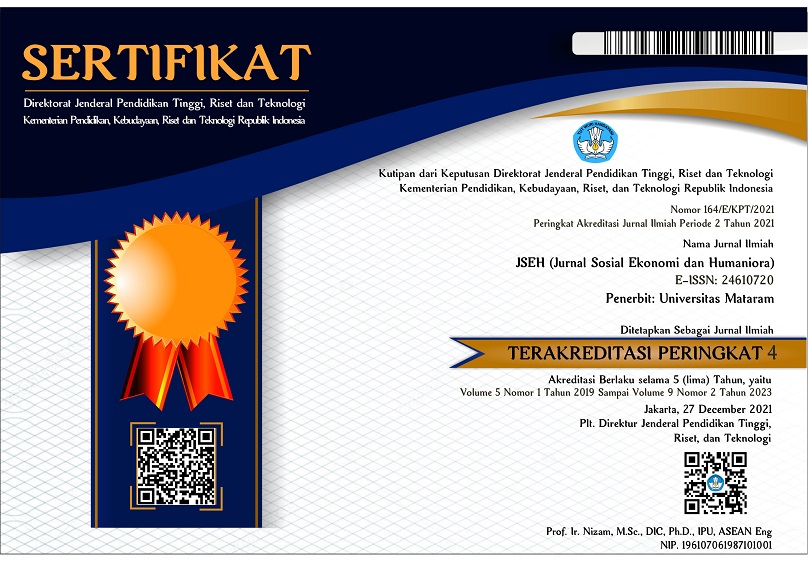POTENSI PENGEMBANGAN WISATA DI KOTA MATARAM BERDASARKAN PERSEPSI DAN PREFERENSI WISATAWAN
Keywords:
potential, tourism development, perceptions, preferences, touristsAbstract
The purpose of this study was to determine the potential for tourism development in the city of Mataram based on tourist perceptions and preferences. The method of proving the research objectives uses descriptive research methods. Primary data collection will be carried out by in-depth interviews. The results of the study will show the tourism potential in the city of Mataram and how the development is based on the perceptions and preferences of tourists in tourist locations in the capital of NTB Province. The results of this study indicate that the perception of tourists about the potential for tourism development in the city of Mataram is high, meaning that tourists consider the city of Mataram still has the potential to be developed into a classy tourist destination. In general, based on tourist preferences for tourism development in the city of Mataram, the existing attractions, amenities, ancillaries and accessibility are still very possible to be developed. In general, the improvisations that expected by tourists are including facilities, the tourism attraction management and environmental cleanliness.
References
Alma, B. (2008). Manajamen Pemasaran dan Pemasaran Jasa. Manajamen Pemasaran dan Pemasaran Jasa. Alfabeta.
Amdani, S. (2008). Analisis Potensi Obyek Wisata Alam Pantai di Kabupaten Gunung Kidul. http://eprints.ums.ac.id/967/1/E100020020.pdf
Aquarita, D., Rosyidie, A., & Pratiwi, W. D. (2017). Potensi Pengembangan Kawasan Bandara Internasional Soekarno Hatta dan Kota Tangerang menjadi Aerotropolis. Jurnal Pengembangan Kota, 5(2), 121–130. https://doi.org/10.14710/jpk.5.2.121-130
Assael, H. (1992). Consumer Behavior and Marketing Action. (4th ed.). PWS- KENT Publishing Company.
Badan Pusat Statistik (2010), Kota Mataram dalam Angka Craven, D. (1997). Pemasaran Strategis (4.). Erlangga.
Creswell, J. W., & Poth, C. N. (2014). Research Design: Qualitative, Quantitative, And Mixed Methods Approaches (4th ed.). SAGE Publications, Inc.
Darwini, S., & Dkk. (2019). Analisis Potensi Pengembangan Desa Wisata Di Kabupaten Lombok Barat. Laporan Penelitian Dana Internal UNRAM.
Dwiputra, R. (2013). Preferensi Wisatawan Terhadap Sarana Wisata Di Kawasan Wisata Alam Erupsi Merapi. Jurnal Perencanaan Wilayah Dan Kota, 24(1), 35– 48.
Eko Yulianto, Idah Uziadanisah, & Firmansyah. (2008). Identifikasi Persepsi dan Preferensi Wisatawan dan Pengusaha di Kawasan Wisata Terpadu Bojongsari - Kabupaten Indramayu.
Ferdinand, A. . (2014). Metode Penelitian Manajemen. BP Universitas Diponegoro.
Hawkins, D. I., Best, R., & Coney, K. (1997). Consumer Behavior: Building Marketing Strategy. Mc Graw-Hill Companies, Inc.
Imran, H. A. (2017). Peran Sampling Dan Distribusi Data Dalam Penelitian Komunikasi Pendekatan Kuantitatif. Jurnal Studi Komunikasi Dan Media ,21(1),111–126. https://media.neliti.com/media/publications/196593-ID-peran-sampling-dan-distibusi-data-dalam.pdf
Kemenpar. (2015). Kajian Pengembangan Wisata Syariah,. Asisten Deputi Penelitian Dan Pengembangan Kebijakan Kepariwisataan Deputi Bidang Pengembangan Kelembagaan Kepariwisataan Kementerian Pariwisata RI.
Koranti, K., Sriyanto, S., & Lestiyono, S. (2017). Analisis Preferensi Wisatawan Terhadap Sarana Di Wisata Taman Wisata Kopeng. Jurnal Ilmiah Ekonomi Bisnis, 22(3), 242–254. https://doi.org/10.35760/eb.
Kotler, P., & Amstrong G., 2015 . (2015). Principles of Marketing. Prentice Hall Inc.
Pauwah, Y., Kumurur, V. A., Sela, R. L. ., & Rogi, O. H. A. (2013). Persepsi dan Preferensi Pengunjung Terhadap Kawasan Wisata Pantai Malalayang. Sabua, 5(1), 16 – 27. https://ejournal.unsrat.ac.id/index.php/SABUA/article/view/1682/3699
Permadi, L. A. et al. (2014). Pengembangan Desain Fasilitas Pendukung Jasa Wisata Religi Berdasarkan Kriteria Evaluasi Konsumen Di Pulau Lombok.
Permadi, L. A. et al. (2018). Analisis Potensi Pengembangan Desa Wisata Di Kabupaten Lombok Tengah. Universitas Mataram.
Permadi, L., Darwini, S., Retnowati, W., & Wahyulina, S. (2019). Persepsi Dan Preferensi Wisatawan Muslim Terhadap Sarana Dan Prasarana Wisata Halal Di Lombok (Studi Kasus Kawasan Ekonomi Khusus Mandalika). Jurnal Sosial Ekonomi Dan Humaniora. JURNAL SOSIAL EKONOMI DAN HUMANIORA,
, 57–70. https://doi.org/10.29303/jseh.v4i2.14
Sugiyono. (2016). Metode Penelitian Kuantitatif, Kualitatif dan R&D. PT Alfabet.
Suwardjoko, P., Warpani, & Indira, P. (2007). Pariwisata dalam Tata Ruang Wilayah. Penerbit ITB. Penerbit ITB.
Wardhani, W., Sumarwan, U., Yuliati, L. N., Widya Wardhani, Ujang Sumarwan, & Lilik Noor Yuliati. (2016). Pengaruh Persepsi dan Preferensi Konsumen terhadap Keputusan Pembelian Hunian Green Product. Jurnal Manajemen Dan Organisasi, 6(1), 45. https://doi.org/10.29244/jmo.v6i1.12183
Yoeti, O. (1996). Pengantar Ilmu Pariwisata (Edisi Revisi). Penerbit Angkasa.
Zikmund, W. G., Babin, B. J., Carr, J. C., & Griffin, M. (2010). Business Research Methods. South-Western Cengage Learning. https://books.google.co.id/books?id=pexMPgAACAAJ
Downloads
Published
How to Cite
Issue
Section
License

This work is licensed under a Creative Commons Attribution-NonCommercial 4.0 International License.








